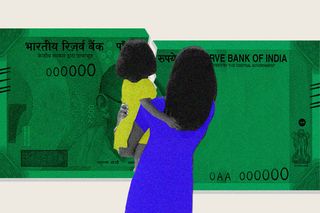
How ‘Motherhood Penalty,’ Divorce Impact Single Mothers
Workplace bias against mothers and the cost of partner absence after divorce both affect single mothers’ economic well-being, shows new research.

The cultural idea of the single mother is fraught with an air of negligence. The mother who chooses to live alone is deemed careless, selfish, and irresponsible enough to choose the absence of a partner over a secure lifestyle with the “primary breadwinner” of the family. The stereotype closely interlinks single mothers with a financial crunch — suggesting that it’s the choice they made thathas pushed the family to an economic disadvantage.
There is only one truth to this stereotype: that single mothers are more likely to face a financial crunch and have compromised economic well-being than single fathers. But according to new research, it doesn’t only have to do with divorce and separation. The many barriers mothers face in accessing work result in a significant wage loss, further jeopardizing single mothers’ financial health.
Published in the journal Demographyon Tuesday, the study is one of its kind to contextualize the economic challenges single mothers face. It is not only a disruption in relationship status and a severed link with the institution of marriage, but the “motherhood wage penalty” continues to factor in as well. The research not only highlights the many pain points that structurally alter the economic security of single mothers, but also pushes for a reimagining of the way we support single mothers and their families.
It is among the worst-kept secrets of the workplace that motherhood comes with a penalty. Working women face cultural biases that stand to question their competence and skills, further restricting their mobility and access to better pay and welfare. And for single mothers and the families they lead, this biased churn results in deeper economic insecurity.
In the present research, Susan Harkness from the University of Bristol, gleaned 25 years of income data of single mothers in the U.S., to understand the multifaceted reasons for theireconomic disadvantage. The more understood factors she found were divorce, the cost of partner absence, and the increased financial needs of raising a child alone. But equally prevalent in deciding a single mother’s well-being was how the labor market imposed penalties on motherhood — they all combined to systemically disadvantage single women.
“Importantly I found the transition to motherhood has just as large an impact on single mothers’ income as the absence of an earning partner,” Harkness said in a press release. “When a woman becomes a mother, she is more likely than the male parent to take time out of the workforce, reduce her hours or miss out on opportunities for career progression for various reasons. These earnings penalties make women much more vulnerable financially in the event of separation or divorce.”
Related on The Swaddle:
A Series of Charts Shows Mothers Take an Income Hit All Over the World
This is what she termed the “accumulation of disadvantage” — a framework, of sorts, to understand how motherhood and relationship disruptions pile atop each other to result in single mothers’ economic insecurity.
This finding is more pertinent in the context of the pandemic as well as rising costs the world over. Reports show several accounts of women skipping meals, working overtime, and being wracked with debt. According to a U.S. estimate, single mothers experienced high unemployment rates; they were also more likely to drop out of the workforce as compared to single fathers or women without children. In countries like India, the weight of prejudice against single mothers is also an ideological barrier that manifests at work and in personal life.
The crisis of economic well-being among single mothers, then, needs a deeper look. What this means is we’ve been overlooking a key component of supporting and providing welfare to single mothers — which is also few and far in between. “A great deal of past research has looked at how partner absence — rather than earnings losses associated with motherhood — affect income,” the study notes. But what goes amiss is the “importance of maternal child earnings penalties — and not just family structure — for explaining single mothers’ disadvantage…”
Most policies globally address the aftermath of a separation, of trying to absorb single parents in welfare schemes and job opportunities. But the research offers a compelling argument to reframe support as something that is continuous and preemptive. We need to “focus on maintaining female employment and earnings following childbirth, such as the provision of job-protected family leave and support for childcare. While important, interventions that focus on moving mothers into work after they become single parents are likely to arrive too late,” Harkness noted.
What this research tells us is that the tectonic shifts in the economy are pushing single parents to the edge — but more so for women who are at a structural disadvantage due to the penalties society imposes for motherhood. Harkness points out that “what we really need is to address the economic disadvantage women experience when they become mothers.”
Saumya Kalia is an Associate Editor at The Swaddle. Her journalism and writing explore issues of social justice, digital sub-cultures, media ecosystem, literature, and memory as they cut across socio-cultural periods. You can reach her at @Saumya_Kalia.
Related


The Transphobia Against Elliot Page Unintentionally Shows the Fragility of Gender Norms
